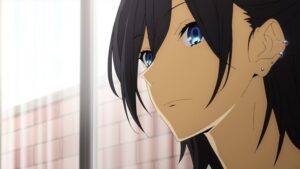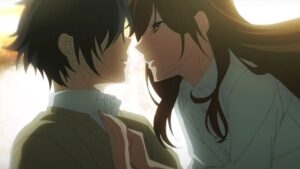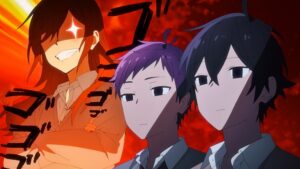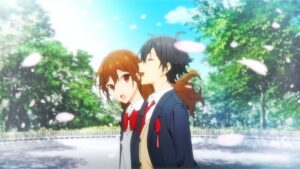It’s hard to be a romcom in a post-Kaguya-sama world. Audiences have gone gaga for that series’ arc-based storytelling and high attention to detail, creating a narrow set of expectations for other works in the genre. A show like Horimiya, which opted for a snapshot style to depict its much larger cast, was bound to face criticism for that decision. Despite that looseness resulting in a handful of marginalized characters, however, the anime did right by its primary couple, and even managed a couple of good spotlight episodes for its secondary cast. Over the course of 13 episodes, Hori and Miyamura’s relationship evolved from a tentative experiment to a lifelong commitment, with moments of both empathy and sensuality along the way. No one else in their unwieldy friend group reached that level of exploration, but the series managed to find consistent voices for several of them (most notably Yuki, who had really come into her own by the end). I’ll admit that Horimiya batted well below a thousand, but it had more hits than misses, so I’m here to play defense for it – mostly, anyway.
Looking back at my first Horimiya post, I noted the show’s tendency to focus on individual moments rather than create a full picture of time. While this strategy was more noticeable when it came to the side characters, it was evident as early as the second episode, where Hori’s home life, interest in Miyamura, and conflict with the student council felt informally segmented. This approach ended up being fairly controversial, but taking a broader view of the series, it was effective in covering a full year of its central relationship. We got the highlights of each phase as they got to know one another, grew comfortable together, became physically intimate, and pledged to stay together during the next chapter of their lives. That third phase may be my favorite – so few anime depict teenage sexuality in honest fashion, and Horimiya not only got it right, but allowed its female lead to initiate things. If the show hadn’t been so willing to jump through time, their coupling may have required more groundwork to be laid, making it feel more calculated and less authentic.
While I’m on the topic of Hori and Miyamura’s first time, I want to mention the show’s visual presentation, especially its use of light and shadow. Many of the scenes leading up to the pair’s intimate encounter took place at dusk, and used the sunset’s shadows to throw their expressions into sharp relief, emphasizing the longing they felt for each other. Similar techniques were used throughout the show’s run to underscore characters’ feelings, particularly in the second half – I remember Yuki’s memories having a wide range of affects applied to them during her breakout episode. From honey-colored thoughts of her crush to darkened recollections of her lies to a romantic rival, her emotions came through as clear as day. Horimiya did an admirable job of applying these accents to key scenes – other aspects of its production weren’t so pretty, though. In my eyes, the show’s single biggest fault lies with its background art, which consisted largely of sterile interiors with sparse, computerized décor. My patience with the artificiality of anime backgrounds shrinks with each passing year, but these were lousy even by modern standards.
Coming back to the characters, it has to be said that while Horimiya’s main duo were nicely realized, the series spread itself too thin to honor its many secondary players. Some, like Honoka and Shu, hardly registered as part of the story due to their lack of involvement; others, like Sakura, received dramatic stories but were too far down on the show’s list of priorities to capitalize. Even Ishikawa, best friend to the protagonist, failed to make the most of his love triangle plot despite having multiple cracks at it. Many of these casualties can be traced back to Horimiya’s highlight reel structure, but the show’s ability to jump from one side character to another also created plenty of opportunities for humor. Additionally, the multiple perspectives that resulted from those jumps demonstrated that Horimiya was about more than a couple of high school lovebirds. Really, it was about being young and inexperienced, and having to confront difficulty and pain in spite of those limitations.
Pain was woven into the histories of so many of these characters, from Hori’s abandonment issues to Yuki’s self-denial to Sakura’s crippling lack of confidence. Even Honoka, whose appearances could be counted on one hand, was struggling with a death in her family from the time we met her. It was Miyamura’s lonely childhood, however, that resonated most clearly throughout the show’s run. The flashbacks to those dark days served as a contrast to his much more fulfilling high school life, but their impact was never forgotten – ultimately, that’s what made this show stand out to me, despite its occasional misfires. Miyamura’s conversations with his alternate self, his hesitation in unfamiliar social situations, and his profound gratitude for Hori’s love all painted a picture of a kid who had been seriously hurt in the past. And yet, he found friends who stood by him and a partner who accepted him, baggage and all. It wasn’t a perfect ending, because no such thing exists – but it was good, and sometimes that’s enough.







This was a lovely review. Captured the strengths and weaknesses of the show. Even waxed a little poetic.
But what we really want to know is – what’s the score out of 100??!
Thanks man!
No scores for me from now on, at least for series reviews. Numbers are incredible tools, but in the context of evaluating art I find them nearly worthless. I’d rather people read my waxy poetry than fixate on a two-digit distillation of my opinion.